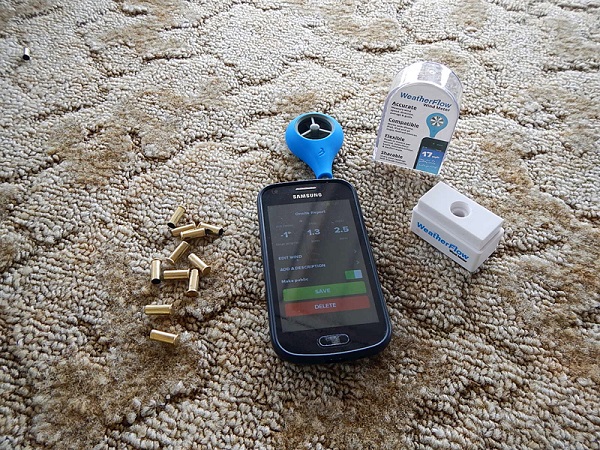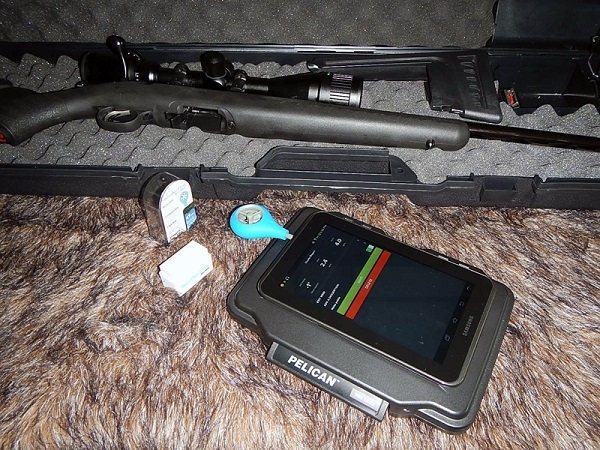 [Editor’s Note: This is a review done by one of reThinkSurvival.com’s fans, Douglas. I do appreciate his review of this product greatly and hope it helps you.]
[Editor’s Note: This is a review done by one of reThinkSurvival.com’s fans, Douglas. I do appreciate his review of this product greatly and hope it helps you.]
What they say:
WeatherFlow is proud to announce the WeatherFlow Wind Meter – it’s an anemometer that fits in your pocket. It’s the first hardware product we have created for the general wind & weather addicted community. It’s compatible with iPhone, iPad, iPod, and all major Android devices.
Download one of our free apps for iOS or Android and plug in your wind meter – it’s really that easy. Hold it up high facing into the wind. Your phone does the rest by recording the wind speed (average and gust), wind direction and location. Easily share onsite reports with WeatherFlow, Instagram, Vine, Twitter, SMS, Email, Facebook. And view all of this crowd-sourced weather in one of our consumer applications.
The Wind Meter, although not a scientific instrument, is designed to be better than any other handheld anemometer on the market. It’s operating range extends from the smallest puff (2 mph) to well over hurricane force winds (125 mph). Calibrated at the University of Florida’s Aerospace Engineering Department, our Wind Meter is accurate to the larger of +/- 0.5% of the reading or 0.2 mph at up to 15° off-axis. That means even if you don’t hold it directly into the wind, you’ll still get very accurate wind speed information.
Not only do we have one of the most accurate and coolest handheld wind meters on the market, at $34.95 it’s also one the most affordable. So what are you waiting for? Get one now!
What I say:
A Strong Case
When I received the WeatherFlow Wind Meter (anemometer), the first thing I noticed was the well designed, sturdy plastic container in which it arrived. Not having to find a storage case, or carve out a niche in a sturdy container is definitely a plus, especially when you are going “minimalist”. The WeatherFlow Wind Meter will do well in a backpack, glove box, or even a jacket pocket the case dimensions are a mere 3 ¾” tall, 2 7/8” wide by 1” deep (roughly 9.5mm x 73mm x 25.4mm).
The Anemometer
The instrument itself which is made of durable plastic appears as an inverted teardrop (see images), with what appears to be a standard stereo headset plug molded into the bottom. The blades are well recessed inside the housing which will help prevent damage. The instrument transfers wind speed data to the phone when plugged in to the headset fitting on your phone and the appropriate application installed and turned on. Note: It may require one additional restart of the software during the installation; at least it did on my tablet. From then on it immediately recognized the meter.
The software interface is fairly intuitive. The menu offers, Take a reading, Settings, History, Order online. In settings, it offers, Activity (listing) a custom Activity (you can name), Speed units (Miles per hour, Knots, Kilometers per hour, Meters per second, Beaufort), Direction display (degrees or text) Magnetic Declination (True North or Magnetic North), Maximum sample period (from 3s – 60s) they may be working on a constant option.
My Devices
The WeatherFlow is compatible with iPhones, iPads, iPods and most Android devices. Check their website for a reasonably complete list. In my tests I used both a Samsung Galaxy Ace II phone and a Samsung Galaxy Tab 2 7.0 tablet. Both are Android systems. The software needed is available for free on Google Play and/or the App Store.
One of the nice features of the WeatherFlow Wind Meter’s software is the ability to fairly quickly share the wind data to other nearby devices, or via social media, e-mail, etc. You should take a quick visit to www.weatherflow.com and review their weather networks, data applications, weather modeling and slew of consumer products as well.
WeatherFlow Wind Meter vs. Speedometer
You guessed it, in the still the morning air on my first day of testing, I (as a passenger) rolled down the window of the car and compared the meter’s output to that of the speedometer of the car. Knowing the meter is rated up to 125 mph, I felt comfortable exposing the meter and the phone to a “road test”. I am happy to report that once we agreed on Kilometers per Hour as opposed to Miles per Hour (the app can give those readings plus Knots, Meters per Second, and Beaufort), the speedometer and the anemometer were in complete agreement that we drive safely and slightly under the speed limit.
WeatherFlow Wind Meter vs. Kestrel(s)
We have a friendly group of folks at the range most are quite willing to help out, lend a hand, offer advice and even politely listen. I quickly found a few long range target shooters who were quite interested to see this anemometer in person. Most had seen the advertisements, and a few videos online regarding this product.
A few of these gents broke out their quite fancy Kestrel Meters Handheld weather stations/wind meters. These meters and are quite popular in the shooting community and I should point out that their instruments start at 3-4 times the price of the WeatherFlow Wind Meter and with all the “bells and whistles” can top out at as much as 16 times the price. The focus of our test would be using only the anemometer functions of their devices for comparison.
All the meters were positioned to face the prevailing wind each having “clear air” to compare the sensitivity. While the afternoon was mostly only light breezes punctuated 2 -4 mph, with the occasional gust to 7mph this meter faired quite well, generally giving the same or quite similar readings as the more expensive units.
One thing that became immediately obvious was that this instrument would be an excellent training device for estimating wind speeds in the field, and not just for shooters.
WeatherFlow Wind Meter vs. Home Weather Station
A neighbor down by the beach has a lovely personal weather station at his home with all the bells and whistles including an anemometer. We dropped by for tea and a quick comparison. Again wind speeds were in agreement with only slight variances which he noted was most likely due to the height of his anemometer (well above the roofline), as opposed to my WeatherFlow being safely held on the porch approximately two stories below.
WeatherFlow Wind Meter vs. Marine Weather
Marine weather reports are critical to safe boating. Things can get “tricky” on even the seemingly nicest of days. This is especially true for kayakers and canoers; we are human powered so it’s especially nice to know what you are working with, or in the case of a headwind, against! Once our confidence in WeatherFlow was established, we enjoyed a few short trips approximately 5 – 8 miles offshore to take some readings and compare them with the government weather predictions. Their data are fairly accurate in a broad sense, with all the equipment they have out there these days our coasts are dotted with excellent weather stations and weather buoys but it was nice to have even more localized readings when paddling anywhere on the Pacific Coast. Being able to take local readings, helps give us a better estimation as to if we want to put in, or which direction will give us a downwind run “home”.
The WeatherFlow performed well, but I was a little nervous as to the durability of the instrument regarding exposure to salt spray, not to mention my phone as I don’t have a safety strap on it. Most likely from here on out my readings will be taken while still ashore.
What is out there regarding portable anemometers?
There are a few manufacturers of anemometers that plug into your cellphone or tablet. They are similarly priced. I have not used them, so you’ll most likely want to check out reviews and videos to be found out there.
There are standalone anemometers, some (more like mini weather stations) with temperature, barometric pressure, etc. Often the more features, the more you will pay. The Kestrel models I used to compare the anemometer functions cost 4-16 times more than this and some even have Bluetooth features that send updated data constantly to ballistic software (like the app I use on my phone and tablet). One such app I like, Sniper Calc Pro (for Android) does just that. I spoke with their development team and they are aware of the WeatherFlow and have requested the SDK from them, but as of this writing, I have no news.
Pros
- For the price, this is an accurate anemometer that is competitive with devices costing several hundreds of dollars.
- I can imagine several sports and even occupations that this would be a handy device for.
- It’s compact, portable, seems durable.
- Several additional apps (see their website) use this data and data can be stored and shared.
- The WeatherFlow Wind Meter makes a great little “trainer” for those developing their Kentucky windage skills.
- It makes a great gift for sportsmen and outdoor enthusiasts of all kinds.
Cons
- This device trusts that you have the ability to at least judge wind direction to at least 15° accuracy. If not a small portable wind vane might be handy.
- This anemometer is not “stand alone” you must have a working (charged) cell phone or tablet to use it. If your battery goes dead or your phone/tablet bricks… you’ll have a lovely gift for a friend. 🙂
- Currently does not interact with my (or any that I know of) ballistics software in “real time”. If it did, as a shooter, I’d be thrilled.
Editor’s Note: Overall, I’d suggest that a compact wind meter such as this Weatherflow Wind Meter can prove useful to your preps be it at the shooting range or just for fun while out boating.]


Leave a Reply